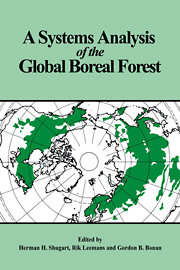Book contents
- Frontmatter
- Contents
- List of contributors
- 1 Introduction
- Part 1 Processes in boreal forests
- Part 2 Patterns in space and time in boreal forests
- Part 3 Computer models for synthesis of pattern and process in the boreal forest
- Introduction
- 12 Individual-tree-based models of forest dynamics and their application in global change research
- 13 Population-level models of forest dynamics
- 14 A spatial model of long-term forest fire dynamics and its applications to forests in western Siberia
- 15 A simulation analysis of environmental factors and ecological processes in North American boreal forests
- 16 The biological component of the simulation model for boreal forest dynamics
- 17 Role of stand simulation in modeling forest response to environmental change and management interventions
- 18 Concluding comments
- References
- Index
13 - Population-level models of forest dynamics
Published online by Cambridge University Press: 12 January 2010
- Frontmatter
- Contents
- List of contributors
- 1 Introduction
- Part 1 Processes in boreal forests
- Part 2 Patterns in space and time in boreal forests
- Part 3 Computer models for synthesis of pattern and process in the boreal forest
- Introduction
- 12 Individual-tree-based models of forest dynamics and their application in global change research
- 13 Population-level models of forest dynamics
- 14 A spatial model of long-term forest fire dynamics and its applications to forests in western Siberia
- 15 A simulation analysis of environmental factors and ecological processes in North American boreal forests
- 16 The biological component of the simulation model for boreal forest dynamics
- 17 Role of stand simulation in modeling forest response to environmental change and management interventions
- 18 Concluding comments
- References
- Index
Summary
Introduction
It has been a long-standing tradition in mathematical ecology to use dynamical equations in the modeling of population dynamics. These equations are intended to describe the ecological mechanisms ruling the observed dynamics of a system, and radically excel formalized descriptions such as regression formulae, which feature widely in the modeling literature, including that for forest modeling.
The various forms of forest (or stand) dynamics models can be subdivided, for our purposes, into three types (for a full review and details see Shugart (1984)):
(a) Models with zero-level averaging over a tree population. They are based on the dynamics of individual trees with individual coordinates: spatial models in the exact sense of the word (Newnham & Smith 1964; Ek & Monserud 1974; Mitchell 1969; West 1987; Gurtzev & Korzukhin 1988).
(b) Models with an intermediate degree of averaging. They operate by considering individual trees but without their spatial location (Botkin, Janak & Wallis 1972; Shugart & West 1977; Shugart 1984; Huston & Smith 1987; Leemans & Prentice 1989), and form the family of so called ‘gap models’ (see Shugart & Prentice, this volume, Chapter 12).
(c) Models with the maximum degree of averaging. They operate by considering groups of trees – parts of a whole population – chosen depending on the particular task (usual subdivisions are by size and/or by age) (Ek & Monserud 1979; Kapur 1982; Korzukhin, Sedych & Ter-Mikaelian 1987, 1988; Tait 1988; Korzukhin, Antonovski & Matskiavichus 1989; Prentice et al. 1989; Kohyama 1989).
- Type
- Chapter
- Information
- A Systems Analysis of the Global Boreal Forest , pp. 334 - 372Publisher: Cambridge University PressPrint publication year: 1992
- 4
- Cited by



